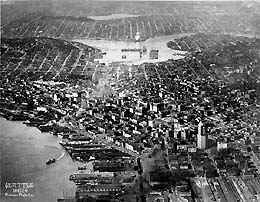On April 28, 1939, members of two rival unions brawl near the Skinner & Eddy dock on the southeastern shore of Lake Union in Seattle. The men are fighting over which union has jurisdiction over crews on cannery ships that are preparing to sail north. An estimated 500 to 1,000 men participate in the pitched battle, which lasts for at least five minutes, injures dozens of men, and sends six men to jail. Onlookers are forced to take evasive action to avoid rocks flung by the fighters. The ships sail north the next day without further incident.
Trouble Brewing
Trouble brewed in the spring of 1939 between two rival unions over which union had jurisdiction over crews operating ships taking supplies and equipment north for the salmon canning industry. The Alaska Fishermen’s Union, a member of the Congress of Industrial Organizations (CIO), had signed an agreement with the Alaska Pacific Canning Company to operate their supply ships. But the Cannery Tendermen’s Union, a member of the American Federation of Labor (AFL), objected, arguing that cannery tendermen fell under the jurisdiction of their union because cannery workers “logically belong[ed] to their organization” (
Seattle P-I,
April 28, 1939).
The dispute erupted into a small fracas on the afternoon of April 27 at Pier 40 on Puget Sound. Three cannery tenders were at the pier, preparing to leave for Alaska. Members of the two rival unions congregated at the pier. Insults were traded, knives flashed, and fists flew in the brief exchange. Two men were injured seriously enough to be taken to City Hospital. But it was only a harbinger of the much bigger battle to come.
The next afternoon, three more ships with skeleton crews moored at the Skinner & Eddy dock on the southeastern shore of Lake Union prepared to sail north. At about 6 p.m. on a sunny spring evening, members of the rival unions picketed near the dock, ready for action. Action came when at least 400 CIO members advanced toward the dock to escort the boat crews aboard. But several hundred AFL members were having none of it. They confronted their foes near the intersection of Fairview Avenue N and Eastlake Avenue and tried to stop them. All hell broke loose.
Rocking and Rumbling
Accounts vary of the number of fighters. The
Seattle Daily Times
estimated the crowd at about 500, while the
Seattle
Post-Intelligencer
insisted the total number was closer to 1,000. But both papers agreed that for at least five minutes it was a solid rumble. The dueling factions went at it with fists, knives, and rocks. Some duked it out individually; some fought in large groups. Other wily toughs crouched behind cars and rained rocks on their adversaries. However, since it was early evening on a workday, many who just happened to be passing by were also obliged to duck and dodge to avoid being beaned by an errant projectile. “Rocks were flying in all directions,” explained the
Seattle Daily Times
the next day.
The 15 police officers on the scene when the battle began were briefly overwhelmed, but they were not unprepared. More police officers soon arrived, backed up by a “Black Maria” (paddy wagon) and an ambulance. While the brunt of the brawl was over after five minutes, smaller skirmishes continued for a few minutes more, stopping traffic on Fairview Avenue N and doubtlessly providing a dash of excitement to both participant and spectator on an otherwise placid Friday afternoon.
Meanwhile back at the dock, AFL members managed to board one of the boats, where they unceremoniously tossed one of its CIO crew members overboard and then for good measure lobbed his luggage into the water after him. The other two boats either moved out into Lake Union on their own accord, or had their moorings helpfully removed by the AFL members to make their retreat easier (accounts differ).
Four men were injured seriously enough to require hospital treatment, and many more suffered minor injuries. Six men were arrested. After the battle, the two rival groups backed off to their original positions and warily eyed each other until about 7 p.m., when buses operated by the respective unions came and took the combatants away. Early the next day, two of the ships sailed from the dock without further ado, supervised from shore by approximately 1,000 CIO members bused in for the occasion.
The AFL and CIO merged in 1955.

